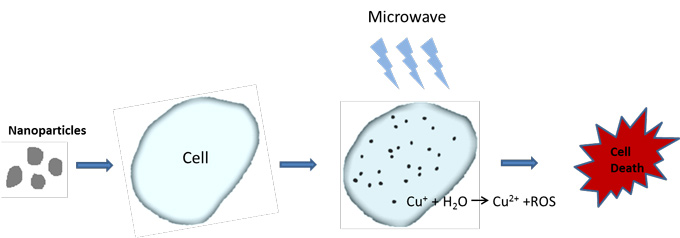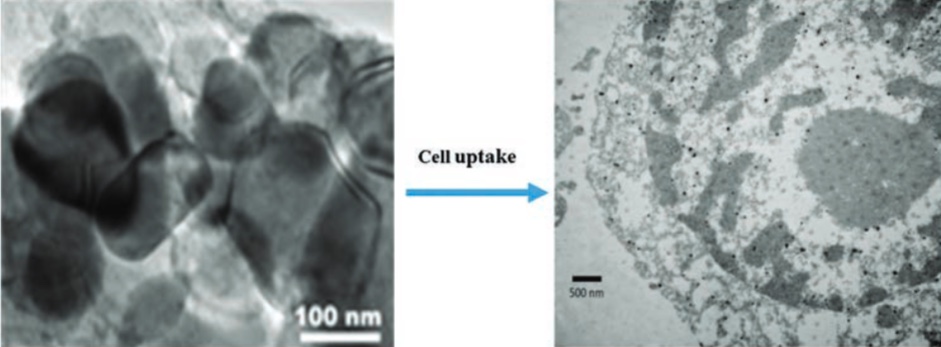Zapping deep tumors with microwave-heated photosensitizer nanoparticle
October 18, 2016

A schematic illustration of microwave-induced photodynamic therapy for cancer treatment (credit: UTA)
Physicists at The University of Texas at Arlington have invented a new photosensitizer nanoparticle called copper-cysteamine (Cu-Cy) that when heated by microwave energy can precisely zap cancer cells deep in the body .
Photodynamic therapy kills cancer cells when a photosensitizer* nanoparticle introduced into tumor tissue is stimulated by (typically) near-infrared light, generating toxic reactive oxygen species (ROS), such as singlet oxygen, by photoexcitation. However, near-IR light cannot penetrate deeper than 10 mm in tissue while retaining enough energy to activate ROS.**
The new “microwave-induced photodynamic therapy (MIPDT)” method can “propagate through all types of tissues and target deeply situated tumors, without harming surrounding tissue,” according to Wei Chen, UTA professor of physics and lead author of the study, published in the October 2016 issue of The Journal of Biomedical Nanotechnology.***

TEM images of Cu-Cy particles (left) and particles after uptake by osteosarcoma cells (right) (Mengyu Yao et al./J. Biomed. Nanotechnol.)
The new nanoparticle demonstrates “very low toxicity, is easy to make and inexpensive, and also emits intense luminescence, which means it can also be used as an imaging agent,” said Chen.
* A photosensitizer is a molecule that can be activated by light to a high-energy state. It may then collide with oxygen and transfer its extra energy to oxygen, forming toxic singlet oxygen.
** In previous research, the researchers found that the Cu-Cy nanoparticle could be activated by X-rays to produce singlet oxygen and slow the growth of tumors. X-ray radiation, however, poses significant risks to patients and can harm healthy tissue. Other photodynamic therapy activation methods that have been explored, with limited results, include upconversion nanoparticles that can be excited at NIR and emit light in the UV-visible range, scintillation or afterglow nanoparticles, and Cerenkov light (generated in nuclear reactors).
*** Scientists from the The Guangdong Key Laboratory of Orthopaedic Technology and Implant Materials, Department of Orthopedics, Guangzhou General Hospital of Guangzhou Military Command, Guangzhou, China; and the Physics Department at Beihang University in Beijing, China, were also involved in the research. The U.S. Army Medical Research Acquisition Activity, the National Science Foundation, the Department of Homeland Security’s joint Academic Research Initiative program, the National Basic Research Program of China, the National Natural Science Foundation of China, and the five-year plan of the Chinese Military.
Abstract of A New Modality for Cancer Treatment—Nanoparticle Mediated Microwave Induced Photodynamic Therapy
Photodynamic therapy (PDT) has attracted ever-growing attention as a promising modality for cancer treatment. However, due to poor tissue penetration by light, photodynamic therapy has rarely been used for deeply situated tumors. This problem can be solved if photosensitizers are activated by microwaves (MW) that are able to penetrate deeply into tissues. Here, for the first time, we report microwave-induced photodynamic therapy and exploit copper cysteamine nanoparticles as a new type of photosensitizer that can be activated by microwaves to produce singlet oxygen for cancer treatment. Both in vitro and in vivo studies on a rat osteosarcoma cell line (UMR 106-01) have shown significant cell destruction using copper cysteamine (Cu-Cy) under microwave activation. The heating effects and the release of copper ions from Cu-Cy upon MW stimulation are the main mechanisms for the generation of reactive oxygen species that are lethal bullets for cancer destruction. The copper cysteamine nanoparticle-based microwave-induced photodynamic therapy opens a new door for treating cancer and other diseases.